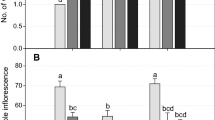Abstract
Inflorescences of Doritaenopsis are commonly induced when the plants are exposed to temperature below 26°C. They need to maintain temperature above 28°C for maintaining the vegetative growth stage and inhibiting inflorescence initiation. We investigated the effects of photoperiod on inflorescence initiation in immature Doritaenopsis at floral inductive temperatures in order to determine an alternative method to prevent inflorescence initiation and to reduce heating expenses. Six-month-old Doritaenopsis Queen Beer ‘Mantefon’ was grown under 9/15 hours (SD), 12/12 hours (MD), 16/8 hours (LD), or SD with night interruption (NI: 22:00–02:00 HR) at 21 or 26°C in module boxes inside a growth chamber. The maximum irradiance was 100 ± 10 and 4 ± 1 μmol·m−2·s−1 during the day and NI, respectively. Inflorescence of the plants was completely inhibited when the plants were grown at 26°C, whereas the plants grown at 21°C could not inhibit inflorescence initiation. However, percent visible inflorescence was reduced greatly in LD when the plants grown at 21°C. NI also reduced visible inflorescence. The LD delayed days to visible inflorescence, followed by MD, NI, and SD when the plants were grown at 21°C. The number of new leaves and leaf span were increased in the plants grown at 26°C more than those grown at 21°C. The plants grown under LD at 21°C had a similar number of new leaves compared to the plants grown at 26°C until 17 weeks of treatment. These results indicated that LD or NI could be an alternative method to high temperature above 26°C for inhibiting inflorescence initiation in immature Doritaenopsis ‘Mantefon’ and could thus save heating costs.
Similar content being viewed by others
Literature Cited
Blanchard, M.G. and E.S. Runkle. 2006. Temperature during the day, but not during the night, controls flowering of Phalaenopsis orchids. J. Expt. Bot. 57:4043–4049.
Blanchard, M.G. and E.S. Runkle. 2009. Use of a cyclic high-pressure sodium lamp to inhibit flowering of chrysanthemum and velvet sage. Scientia Hort. 122:448–454.
Chen, W.S., H.Y. Liu, Z.H. Liu, L. Yang, and W.H. Chen. 1994. Gibberellin and temperature influence carbohydrate content and flowering in Phalaenopsis. Physiol. Plant. 90:397–395.
Erwin, J.E. and R. Warner. 2002. Determination of photoperiodic response group and effect of supplemental irradiance on flowering of several bedding plant species. Acta Hort. 580:95–100.
Goh, C.J. and J. Ariditti. 1985. Orchidaceae, p. 309–336. In: A.H. Halevy (ed). Handbook of flowering. Vol. I. CRC Press, Boca Raton, Fla.
Griesbach, R.J. 1985. An orchid in every pot. Florists’ review 176:26–30.
Hew, C.S. and J.W.H. Yong. 1997. The physiology of tropical orchids in relation to the industry. World Scientific, Singapore.
Ichihashi, S. 1997. Orchid production and research in Japan, p. 171–212. In: J. Arditti and A.M. Pridgeion (eds.). Orchid biology: Reviews and perspectives. Vol. VII. Kluwer Academic Publishers, UK.
Kang, K.J., W. Oh, J.H. Shin, and K.S. Kim. 2008. Night interruption and cyclic lighting promote flowering of Cyclamen persicum under low temperature regime. Hort. Environ. Biotechnol. 49:72–77.
Karlsson, M.G. 2002. Flower formation in Primula vulgaris is affected by temperature, photoperiod, and daily light integral. Scientia Hort. 95:99–110.
Kim Y.J., H.J. Lee, and K.S. Kim. 2011. Night interruption promotes vegetative growth and flowering of Cymbidium. Scientia Hort. 130:887–893.
Krizek, D.T. and R.H. Lawson. 1974. Accelerated growth of Cattleya and Phalaenopsis under controlled-environment condition. Amer. Orchid Soc. Bul. 43:503–510.
Lin, G.M. and N. Lee. 1984. Effect of temperature on growth and flowering of Phalaenopsis white hybrid. J. Chinese Soc. Hort. Sci. 30:223–131.
Lopez, R.G., E.S. Runkle, Y.T. Wang, M.G. Blanchard, and T. Hsu. 2007. Growing the best Phalaenopsis, part 3. Temperature and light requirements, height, insect, and disease control. Orchids 76:184–189.
Mattson, N.S. and J.E. Erwin. 2005. The impact of photoperiod and irradiance on flowering of several herbaceous ornamentals. Scientia Hort. 104:275–292.
Oh, W., I.H. Cheon, and K.S. Kim. 2009. Photosynthetic daily light integral influences flowering time and crop charcteristics of Cyclamen persicum. HortSicence 44:341–344.
Paradiso, R., A. Maggio, and S.D. Pascale. 2012. Moderate variations of day/night temperatures affect flower induction and inflorescence development in Phalaenopsis. Scientia Hort. 139:102–107.
Pollet, B., L. Vanhaecke, P. Dambre, P. Lootens, and K. Steppe. 2011. Low night temperature acclimation of Phalaenopsis. Plant Cell Rep. 30:1125–1134.
Pridgeon, A. 2000. The illustrated encyclopedia of orchids. Timber Press, Portland, OR, USA.
Runkle, E.S. and R.D. Heins. 2003. Photocontrol of flowering and extension growth in the long-day plant pansy. J. Amer. Soc. Hort. Sci. 128:479–485.
Runkle, E.S., Y.T. Wang, M.G. Blachard, and R.G. Lopez. 2007. Growing the best Phalaenopsis, Part 1. An introduction to potted Phalaenopsis orchids. Orchids 76:24–29.
Rotor, G.B. 1952. Daylength and temperature in relation to growth and flowering of orchids. Cornell Univ. Agr. Expt. Sta. Bul. 885: 29–43.
Sakanishi, Y., H. Imanishi, and G. Isida. 1980. Effect of temperature on growth and flowering of Phalaenopsis amabilis. Bul. Univ. Osaka. Pref. Ser. B. 32:1–9.
Tomas, B. and D. Vince-Prue. 1997. Photoperiodism in plants. 2nd ed. Academic Press, New York, NY, USA.
Wang, Y.T. 2007. Average daily temperature and reversed day/night temperature regulate vegetative and reproductive responses of a Doritis pulcherrima Lindley hybrid. HortScience 42:68–70.
Wang, Y.T. and N. Lee. 1994. Another look at an old crop: Potted blooming orchids, Part 2. Greenhouse Grower 12:36–38.
Went, F.W. 1957. The experimental control of plant growth. Chronica Bot. 17:148–152.
Yoneda, K., H. Momose, and S. Kubota. 1991. Effect of daylength and temperature in juvenile and adult Phalaenopsis plants. J. Japan. Soc. Hort. Sci. 60:651–657.
Author information
Authors and Affiliations
Corresponding author
Additional information
These authors contributed equally to this work.
Rights and permissions
About this article
Cite this article
An, S.K., Kim, Y.J. & Kim, K.S. Inhibition of inflorescence initiation in immature Doritaenopsis Queen Beer ‘Mantefon’ by photoperiod and temperature. Hortic. Environ. Biotechnol. 54, 223–227 (2013). https://doi.org/10.1007/s13580-013-0181-0
Received:
Revised:
Accepted:
Published:
Issue Date:
DOI: https://doi.org/10.1007/s13580-013-0181-0



